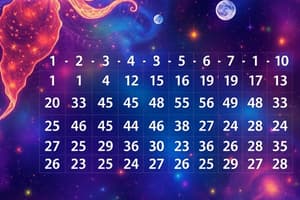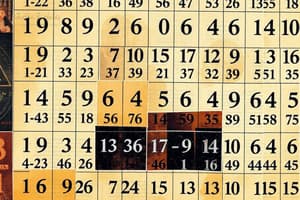Podcast
Questions and Answers
What is the primary function of a multiplication table?
What is the primary function of a multiplication table?
To define multiplication operations by displaying the products of pairs of numbers.
How do you locate the product of two numbers in a multiplication table?
How do you locate the product of two numbers in a multiplication table?
Find the intersection of the row and column representing the two numbers.
What are the first three products of the Table of 2?
What are the first three products of the Table of 2?
2, 4, and 6.
What pattern is observed in multiplication tables regarding symmetry?
What pattern is observed in multiplication tables regarding symmetry?
Why are multiplication tables important for learning math?
Why are multiplication tables important for learning math?
What is one effective learning technique for mastering multiplication tables?
What is one effective learning technique for mastering multiplication tables?
How do visual aids enhance the understanding of multiplication tables?
How do visual aids enhance the understanding of multiplication tables?
What real-life application can multiplication tables assist with?
What real-life application can multiplication tables assist with?
What is a helpful trick for recalling multiples of 9?
What is a helpful trick for recalling multiples of 9?
What should learners do to gradually increase their difficulty in multiplication?
What should learners do to gradually increase their difficulty in multiplication?
Flashcards are hidden until you start studying
Study Notes
Multiplication Tables
-
Definition: A multiplication table is a chart used to define a multiplication operation by displaying the products of pairs of numbers.
-
Basic Structure:
- Rows and columns usually represent the numbers being multiplied.
- The intersection of a row and a column provides the product.
-
Common Multiplication Tables:
- Table of 1:
1 x 1 = 1
1 x 2 = 2
1 x 3 = 3
...
1 x 10 = 10 - Table of 2:
2 x 1 = 2
2 x 2 = 4
2 x 3 = 6
...
2 x 10 = 20 - Table of 3:
3 x 1 = 3
3 x 2 = 6
3 x 3 = 9
...
3 x 10 = 30 - Up to Table of 10.
- Table of 1:
-
Patterns in Multiplication Tables:
- Each row corresponds to multiples of a specific number.
- Numbers in the table are symmetrical; for example, 3 x 4 = 4 x 3.
- Even and odd products distribute evenly across rows.
-
Importance:
- Fundamental for arithmetic operations and advanced math.
- Enhances quick mental calculation skills.
- Forms the basis for understanding more complex concepts like factoring and algebra.
-
Learning Techniques:
- Repetition: Regular practice helps in memorization.
- Visualization: Using charts and visual aids to understand relationships.
- Games and Activities: Engaging methods like flashcards or online quizzes.
-
Application:
- Used in problem-solving in daily life (e.g., calculating total costs).
- Important for standardized tests and academic settings.
-
Tips for Mastery:
- Start with smaller numbers and gradually increase difficulty.
- Relate multiplication to real-life scenarios for better understanding.
- Encourage the use of tricks such as the 9s finger trick for faster recall.
Definition and Structure
- A multiplication table displays multiplication operations, showing products of number pairs.
- Organized in rows and columns representing numbers multiplied together.
- The intersection of a row and a column reveals the product.
Common Multiplication Tables
- Table of 1: Begins with 1, producing products from 1 to 10.
- Table of 2: Products are even numbers from 2 to 20.
- Table of 3: Displays multiples of 3 from 3 to 30.
- Continues with tables up to Table of 10, covering products for all integers up to 10.
Patterns in Multiplication
- Each row illustrates multiples of a specific number demonstrating predictable growth.
- Multiplication is commutative, highlighted by symmetry (e.g., 3 x 4 = 4 x 3).
- Distribution of even and odd products is consistent across rows.
Importance of Multiplication Tables
- Essential for mastering arithmetic operations and paving the way to advanced mathematics.
- Enhances speed and accuracy in mental calculations.
- Lays the groundwork for understanding factoring, algebra, and other higher-level concepts.
Learning Techniques
- Repetition: Consistent practice aids memorization of tables.
- Visualization: Charts and graphical aids help illustrate relationships between numbers.
- Games and Activities: Flashcards, quizzes, and interactive tools make learning engaging.
Application of Multiplication Tables
- Utilized in everyday problem-solving, like budgeting and calculating expenses.
- Critical for success in standardized testing and academic evaluations.
Tips for Mastering Multiplication
- Start with smaller multiplication sets to build confidence before progressing.
- Connect multiplication concepts to real-life situations for enhanced comprehension.
- Use mnemonic tricks, such as the "9s finger trick," to facilitate quicker recall of facts.
Studying That Suits You
Use AI to generate personalized quizzes and flashcards to suit your learning preferences.





